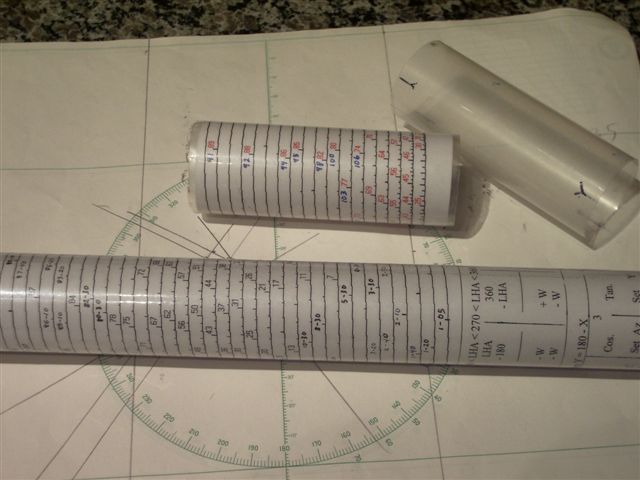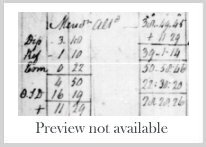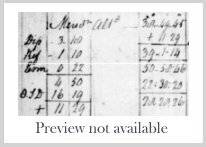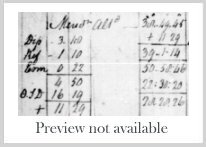
NavList:
A Community Devoted to the Preservation and Practice of Celestial Navigation and Other Methods of Traditional Wayfinding
Re: Cylindrical Slide Rule tube poll
From: Gary LaPook
Date: 2010 Jan 21, 03:52 -0800
Re: [NavList] Re: Cylindrical Slide Rule tube poll
From: Gary LaPook
Date: 2010 Jan 21, 03:52 -0800
The following may give you some more ideas in creating a working
copy of a Bygrave.
http://www.fer3.com/arc/m2.aspx?i=111539&y=201001
http://www.fer3.com/arc/m2.aspx?i=109993
http://www.fer3.com/arc/m2.aspx?i=109378
http://www.fer3.com/arc/m2.aspx?i=109117
http://www.fer3.com/arc/m2.aspx?i=109056
The following was originally posted on July 4, 2009 as message #8949.
-------------------------------------------------------------------------------------
I need to correct the links to the scales for the flat Bygrave, also usable for making a cylindrical Bygrave. The links I had provided were for earlier versions of the scales and the final version corrected some minor issues , using ' instead of " for minutes. So you should download the following pdf files instead:
http://www.fer3.com/arc/img/107501.f2-lapook1.pdf
http://www.fer3.com/arc/img/107501.f2-lapook2.pdf
I believe the original Bygrave was made with a printed scale glued to the tubes much like the Otis King slide rules. My method of making a working model uses the same method except the scale is held on by the clear plastic adhesive protector sheet. This sheet also protects the scales.
You can make adjustments with your printer to get the scales to print out to the correct size to fit around the tube you are using. For the base tube I used a 1-1/2 inch sink drain pipe (I think it is called a "tail piece") 12 inches long, about four bucks at any Home Depot or Do-It Center. Print out the tan/cotan scale and cut it about in half to allow some overlap. Wrap it around the tube, twisting it slightly to get the spirals to line up. After doing this the first time you may you may have to make a slight change to the printer controls to get it to the exact right size, cut and try.
You will need to buy a package of ten "Scotch Self-Sealing Pouches" for about thirteen bucks. These consist of two pieces of plastic one of wich is coated with adhesive, covered with a protective sheet. Cut one of the sticky sheets to overlap the tan/cotan scale. Carefully wrap that scale around the tube and, starting near where the scale overlaps (to hold the joint together), carefully wrap the sticky sheet around it with the overlap at the top and bottom holding everything on to the tube. You might have to start over if it gets stuck in the wrong position but you can, sometimes, peal the plastic back up if necessary to reposition.
Now comes the trickiest part, making the cosine/secant scale. This is made with two of the sticky sheets with the scale sandwiched between. Cut the plastic sheet as before but make a large overlap on the bottom so that it will extend below the cursor tube so that you will be able to move it with the cursor all the way down to the zero mark on the cosine scale. When you print out the cosine scale, and try it on for size around the tan scale, make sure you allow a little bit for the plastic sheet that will be underneath the cosine scale. Now place one of the sticky sheets, sticky side out, and the cosine scale around the tube and and carefully line up the scale. Wrap it tightly enough so that friction will hold it in place and not too tight so that it can be rotated. But, before you do this, consider the overlap of the plastic sheet already set on top of the cotan scale. You want the overlap on the plastic sheet under the cosine scale to be positioned so that it will not hang up on the slight ridge of the the underlying overlap. If you don't allow for this the two overlaps will act like a ratchet or a set of pawls and prevent your rotating the cosine scale in both directions. The next step is to place the second sticky sheet over the cosine scale which is relatively easy to do.
The third step, and the easiest, is to form a clear plastic tube to carry the cursor. I drew a line on a piece of paper and copied it onto a plastic transparency sheet using my ink jet printer. On earlier versions I just drew the two indexes with a marker, their alignment is not critical. Form this into a tube to wrap around the cosine scale and use tape to hold its shape or a piece of one of the sticky sheets. The length of this tube must be slightly more than the height of the cosine scale since it must be able to reach from the zero mark on the cosine scale to extend past the top of that scale so that it points onto the cotan scale.
There are some frustrating points in this process and the flat version is much easier to make but the cylindrical version is easier to use.
gl




Hein Bodahl wrote:
http://www.fer3.com/arc/m2.aspx?i=111539&y=201001
http://www.fer3.com/arc/m2.aspx?i=109993
http://www.fer3.com/arc/m2.aspx?i=109378
http://www.fer3.com/arc/m2.aspx?i=109117
http://www.fer3.com/arc/m2.aspx?i=109056
The following was originally posted on July 4, 2009 as message #8949.
-------------------------------------------------------------------------------------
I need to correct the links to the scales for the flat Bygrave, also usable for making a cylindrical Bygrave. The links I had provided were for earlier versions of the scales and the final version corrected some minor issues , using ' instead of " for minutes. So you should download the following pdf files instead:
http://www.fer3.com/arc/img/107501.f2-lapook1.pdf
http://www.fer3.com/arc/img/107501.f2-lapook2.pdf
I believe the original Bygrave was made with a printed scale glued to the tubes much like the Otis King slide rules. My method of making a working model uses the same method except the scale is held on by the clear plastic adhesive protector sheet. This sheet also protects the scales.
You can make adjustments with your printer to get the scales to print out to the correct size to fit around the tube you are using. For the base tube I used a 1-1/2 inch sink drain pipe (I think it is called a "tail piece") 12 inches long, about four bucks at any Home Depot or Do-It Center. Print out the tan/cotan scale and cut it about in half to allow some overlap. Wrap it around the tube, twisting it slightly to get the spirals to line up. After doing this the first time you may you may have to make a slight change to the printer controls to get it to the exact right size, cut and try.
You will need to buy a package of ten "Scotch Self-Sealing Pouches" for about thirteen bucks. These consist of two pieces of plastic one of wich is coated with adhesive, covered with a protective sheet. Cut one of the sticky sheets to overlap the tan/cotan scale. Carefully wrap that scale around the tube and, starting near where the scale overlaps (to hold the joint together), carefully wrap the sticky sheet around it with the overlap at the top and bottom holding everything on to the tube. You might have to start over if it gets stuck in the wrong position but you can, sometimes, peal the plastic back up if necessary to reposition.
Now comes the trickiest part, making the cosine/secant scale. This is made with two of the sticky sheets with the scale sandwiched between. Cut the plastic sheet as before but make a large overlap on the bottom so that it will extend below the cursor tube so that you will be able to move it with the cursor all the way down to the zero mark on the cosine scale. When you print out the cosine scale, and try it on for size around the tan scale, make sure you allow a little bit for the plastic sheet that will be underneath the cosine scale. Now place one of the sticky sheets, sticky side out, and the cosine scale around the tube and and carefully line up the scale. Wrap it tightly enough so that friction will hold it in place and not too tight so that it can be rotated. But, before you do this, consider the overlap of the plastic sheet already set on top of the cotan scale. You want the overlap on the plastic sheet under the cosine scale to be positioned so that it will not hang up on the slight ridge of the the underlying overlap. If you don't allow for this the two overlaps will act like a ratchet or a set of pawls and prevent your rotating the cosine scale in both directions. The next step is to place the second sticky sheet over the cosine scale which is relatively easy to do.
The third step, and the easiest, is to form a clear plastic tube to carry the cursor. I drew a line on a piece of paper and copied it onto a plastic transparency sheet using my ink jet printer. On earlier versions I just drew the two indexes with a marker, their alignment is not critical. Form this into a tube to wrap around the cosine scale and use tape to hold its shape or a piece of one of the sticky sheets. The length of this tube must be slightly more than the height of the cosine scale since it must be able to reach from the zero mark on the cosine scale to extend past the top of that scale so that it points onto the cotan scale.
There are some frustrating points in this process and the flat version is much easier to make but the cylindrical version is easier to use.
gl
Hein Bodahl wrote:
On 20.01.2010 06:38, Richard M. Pisko wrote:I think a felt liner would be almost essential for prolonged use. Aluminum tends to blacken surfaces through rubbing. A coating of the paper or plastic would help, and I had even thought of spraying the inside of the outer tube with a thin film of drawing fixative; but I believe that felt would be the best solution.How about protecting the scales with a PVC shrink wrap tube ? http://cgi.ebay.com/ws/eBayISAPI.dll?ViewItem&item=200255742807 A while back Martin Tali posted PostScript files for the scales, it seems to me that using those would be the easiest way to handle the scaling problem of different diameter tubing. I have been thinking about using a 50 or 75mm drain pipe and fixed scales. Around that I would shrink wrap a movable cursor for the cos scale. This transparent wrap, lined to avoid undue friction, would also cover the cotan scale. Around the wrap covering the cotan scale I would wrap a second, movable cursor for the cotan scale. This second cursor would then move in conjunction with the cursor for the cos scale, once set, avoiding the locking problem. This would also provide a cylinder to store the necessary tables. Perhaps... Hein










